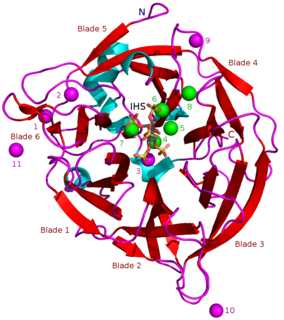Xylanase is any of a class of enzymes that degrade the linear polysaccharide xylan into xylose, thus breaking down hemicellulose, one of the major components of plant cell walls.

Kluyveromyces marxianus in ascomycetous yeast and member of the genus, Kluyveromyces. It is the sexual stage of Atelosaccharomyces pseudotropicalis also known as Candida pseudotropicalis. This species has a homothallic mating system and is often isolated from dairy products.

Piceid is a stilbenoid glucoside and is a major resveratrol derivative in grape juices. It can be found in the bark of Picea sitchensis. It can also be isolated from Reynoutria japonica, the Japanese knotweed.

Aureobasidium pullulans is a ubiquitous and generalistic black, yeast-like fungus that can be found in different environments. It is well known as a naturally occurring epiphyte or endophyte of a wide range of plant species without causing any symptoms of disease. A. pullulans has a high importance in biotechnology for the production of different enzymes, siderophores and pullulan. Furthermore, A. pullulans is used in biological control of plant diseases, especially storage diseases.
D-amino-acid dehydrogenase is a bacterial enzyme that catalyses the oxidation of D-amino acids into their corresponding oxoacids. It contains both flavin and nonheme iron as cofactors. The enzyme has a very broad specificity and can act on most D-amino acids.

The Ustilaginaceae are a family of smut fungi in the order Ustilaginomycetes. Collectively, the family contains 17 genera and 607 species.
Streptomyces natalensis is a bacterial species in the genus Streptomyces.
Microbiologically induced calcium carbonate precipitation (MICP) is a bio-geochemical process that induces calcium carbonate precipitation within the soil matrix. Biomineralization in the form of calcium carbonate precipitation can be traced back to the Precambrian period. Calcium carbonate can be precipitated in three polymorphic forms, which in the order of their usual stabilities are calcite, aragonite and vaterite. The main groups of microorganisms that can induce the carbonate precipitation are photosynthetic microorganisms such as cyanobacteria and microalgae; sulfate-reducing bacteria; and some species of microorganisms involved in nitrogen cycle. Several mechanisms have been identified by which bacteria can induce the calcium carbonate precipitation, including urea hydrolysis, denitrification, sulphate production, and iron reduction. Two different pathways, or autotrophic and heterotrophic pathways, through which calcium carbonate is produced have been identified. There are three autotrophic pathways, which all result in depletion of carbon dioxide and favouring calcium carbonate precipitation. In heterotrophic pathway, two metabolic cycles can be involved: the nitrogen cycle and the sulfur cycle. Several applications of this process have been proposed, such as remediation of cracks and corrosion prevention in concrete, biogrout, sequestration of radionuclides and heavy metals.

Poly-γ-glutamate is a metabolite of Bacillus subtilis. Poly-γ-glutamate inhibits tyrosinase and melanogenesis in vitro.
Penicillium citrinum is an anamorph, mesophilic fungus species of the genus of Penicillium which produces tanzawaic acid A-D, ACC, Mevastatin, Quinocitrinine A, Quinocitrinine B, and nephrotoxic citrinin. Penicillium citrinum is often found on moldy citrus fruits and occasionally it occurs in tropical spices and cereals. This Penicillium species also causes mortality for the mosquito Culex quinquefasciatus. Because of its mesophilic character, Penicillium citrinum occurs worldwide. The first statin (Mevastatin) was 1970 isolated from this species.
Penicillium decumbens is an anamorph species of the genus of Penicillium which occurs widespread in nature, mainly in subtropical and tropical soil but it also occur in food. Analysis have shown that Penicillium decumbens has antibiotic activity Penicillium decumbens produces the cyclopentenone cyclopenicillone
Penicillium melinii is an anamorph species of the genus Penicillium which produces griseofulvin and beta-Nitropropionic acid.
Penicillium oxalicum is an anamorph species of the genus Penicillium which was isolated from rhizosphere soil of pearl millet. Penicillium oxalicum produces secalonic acid D, chitinase, oxalic acid, oxaline and β-N-acetylglucosaminidase and occurs widespread in food and tropical commodities. This fungus could be used against soilborne diseases like downy mildew of tomatoes
Penicillium solitum is an anamorph, mesophilic, salinity-tolerant, psychrotolerant species of fungus in the genus Penicillium which produces polygalacturonase, compactin, cyclopenin, cyclopenol, cyclopeptin, dehydrocompactin, dihydrocyclopeptin, palitantin, solistatin, solistatinol, viridicatin, viridicatol. This species was isolated from air dried lamb thighs, on Faore Island. Penicillium solitum and Eurotium rubrum are the species which are found during the production of traditional produced Tyrolean smoked and cured ham. Penicillium solitum is a pathogen of pomaceous fruit.
Streptomyces albulus is a bacterium species from the genus of Streptomyces. Streptomyces albulus produces acetoxycycloheximide, aciphenol, albanoursin and cycloheximide.
Streptomyces diastatochromogenes is a bacterium species from the genus of Streptomyces. Streptomyces diastatochromogenes produces polyketomycin, concanamycin A, concanamycin B, concanamycin C, momofulvenone A, azdimycin, toyocamycin and oligomycins.
Streptomyces graminearus is a bacterium species from the genus of Streptomyces. Streptomyces graminearus produces the antibiotic gougerotin.

Velvet complex is a group of proteins found in fungi and especially molds that are important in reproduction and production of secondary metabolites including penicillin. The core members of the complex include VeA, LaeA, and VelB. Other proteins including VelC and VosA sometimes function in the complex. The proteins were first characterized in Aspergillus nidulans.

β-propeller phytases (BPPs) are a group of enzymes (i.e. protein superfamily) with a round beta-propeller structure. BPPs are phytases, which means that they are able to remove (hydrolyze) phosphate groups from phytic acid and its phytate salts. Hydrolysis happens stepwise and usually ends in myo-inositol triphosphate product which has three phosphate groups still bound to it. The actual substrate of BPPs is calcium phytate and in order to hydrolyze it, BPPs must have Ca2+ ions bound to themselves. BPPs are the most widely found phytase superfamily in the environment and they are thought to have a major role in phytate-phosphorus cycling in soil and water. As their alternative name alkaline phytase suggests, BPPs work best in basic (or neutral) environment. Their pH optima is 6–9, which is unique among the phytases.






